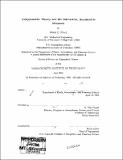| dc.contributor.advisor | R. Alan Plumb. | en_US |
| dc.contributor.author | Privé, Nikki C., 1977- | en_US |
| dc.contributor.other | Massachusetts Institute of Technology. Dept. of Earth, Atmospheric, and Planetary Sciences. | en_US |
| dc.date.accessioned | 2006-07-31T15:27:51Z | |
| dc.date.available | 2006-07-31T15:27:51Z | |
| dc.date.copyright | 2005 | en_US |
| dc.date.issued | 2005 | en_US |
| dc.identifier.uri | http://hdl.handle.net/1721.1/33726 | |
| dc.description | Thesis (Sc. D.)--Massachusetts Institute of Technology, Dept. of Earth, Atmospheric, and Planetary Sciences, 2005. | en_US |
| dc.description | Includes bibliographical references (p. 201-204). | en_US |
| dc.description.abstract | The applicability of axisymmetric theory of angular momentum conserving circulations to the large-scale steady monsoon is studied in a general circulation model with idealized representations of continental geometry and simple physics. The axisymmetric theory is expanded to explain the location of the monsoon; assuming quasi-equilibrium, the poleward boundary of the monsoon circulation will be collocated with the maximum in subcloud moist entropy, with the monsoon rains occurring slightly equatorward of this maximum. Starting from an axisymmetric aquaplanet framework, the model complexity is incrementally increased to include first a subtropical continent, then eddies and zonal variation in the flow, and finally asymmetry of the large-scale forcing. It is found that the meridional circulation which develops over a zonally symmetric continent is in good agreement with the axisymmetric theory, but a cross-equatorial meridional circulation does not form over a continent of limited longitudinal width, where the flow is highly asymmetric. | en_US |
| dc.description.abstract | (cont.) The equator proves to be a substantial barrier to boundary layer meridional flow; flow into the summer hemisphere from the winter hemisphere tends to occur in the free troposphere rather than in the boundary layer. The monsoon location is found to be strongly correlated with the maximum subcloud moist entropy, both in the modeled cases and in observed monsoons around the globe. The net effect of eddies is a slight weakening of the monsoon due to redistribution of the moist entropy field. Advection is found to strongly shape the overall distribution of subcloud moist entropy, and to limit the range of the monsoon circulation and precipitation. | en_US |
| dc.description.statementofresponsibility | by Nikki C. Privé. | en_US |
| dc.format.extent | 204 p. | en_US |
| dc.format.extent | 12102666 bytes | |
| dc.format.extent | 12111275 bytes | |
| dc.format.mimetype | application/pdf | |
| dc.format.mimetype | application/pdf | |
| dc.language.iso | eng | en_US |
| dc.publisher | Massachusetts Institute of Technology | en_US |
| dc.rights | M.I.T. theses are protected by copyright. They may be viewed from this source for any purpose, but reproduction or distribution in any format is prohibited without written permission. See provided URL for inquiries about permission. | en_US |
| dc.rights.uri | http://dspace.mit.edu/handle/1721.1/7582 | |
| dc.subject | Earth, Atmospheric, and Planetary Sciences. | en_US |
| dc.title | Axisymmetric theory and the interactive, asymmetric monsoon | en_US |
| dc.type | Thesis | en_US |
| dc.description.degree | Sc.D. | en_US |
| dc.contributor.department | Massachusetts Institute of Technology. Department of Earth, Atmospheric, and Planetary Sciences | |
| dc.identifier.oclc | 65168513 | en_US |
